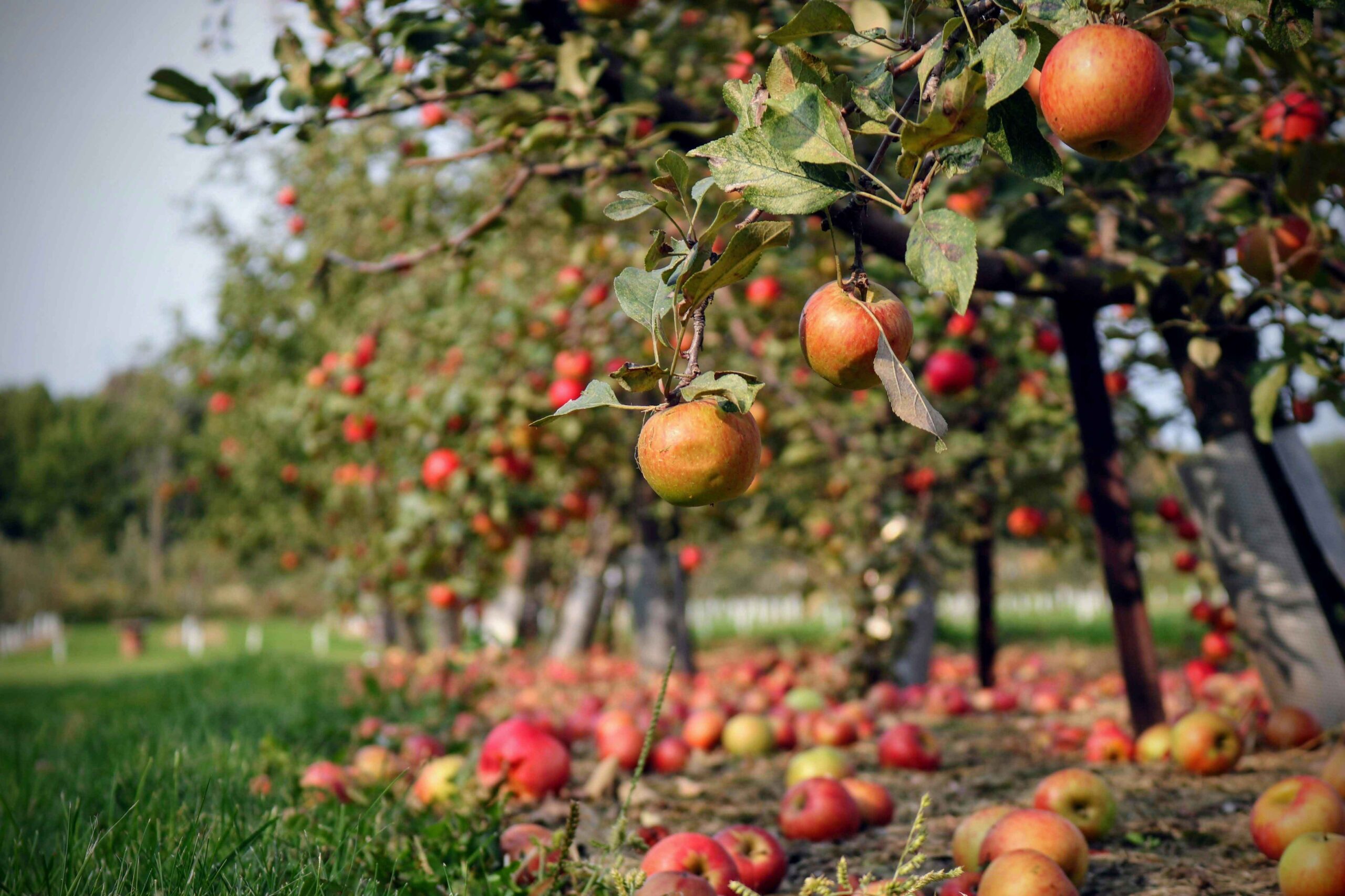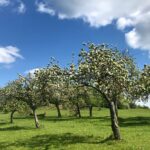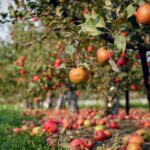When planting apple trees in your garden, giving them enough space to grow and thrive is important. Whether planning to develop a single tree, a couple, or even a small grove, the key to success lies in proper spacing. Standard apple trees should be planted about 20 to 25 feet apart to allow their branches to spread and provide room for manoeuvring during pruning, thinning, and harvesting. On the other hand, dwarf rootstocks are smaller. They can be planted closer together, around 8 to 10 feet, making them perfect for backyard growers with limited space.
Also, read my guides on:
Pruning Apple Trees: When & How to Prune Apple Trees
In my own experience, spacing makes all the difference. I once planted apple trees too close together, and managing their overlapping limbs quickly became a struggle. Proper spacing makes caring for the trees easier and encourages cross-pollination, which is vital for healthy fruit production. Commercial orchardists often maximize output by planting trees closer. However, for home gardeners, following these recommendations helps ensure a productive, manageable orchard.
Choosing the right rootstock and variety of apple trees is also crucial. Dwarf rootstocks are ideal if you’re looking for smaller trees that are easier to care for, while standard apple trees are perfect for larger spaces and bigger yields. Remember, the goal is to enjoy those crisp, sweet apples you can pluck straight fresh off the tree. Careful planning will lead to a fruitful and rewarding apple harvest, whether it’s a compact backyard setup or a sprawling grove.
Why is spacing important?
Proper spacing is key when planting apple trees, as it directly affects their growth, health, and overall productivity. Giving your trees enough room allows their root systems to develop fully while ensuring better air circulation and sunlight penetration. This helps prevent diseases and improves fruit quality. If trees are planted too closely, airflow becomes limited, leading to damp conditions where diseases can thrive. Proper spacing also makes it easier to pick ripe fruit and care for your trees without difficulty.
Spacing also plays a big role in cross-pollination, essential for apple production. Most apple trees rely on nearby trees and insects like bees to transfer pollen between them. For this reason, do not plant trees that require cross-pollination more than 100 feet apart, as this can reduce the chances of successful pollination. To achieve the best results, consider your area, including soil type, drainage, sunlight, and wind exposure. Consulting with a local nursery or experienced horticulturist can help you determine the optimal spacing and growing conditions for your apple trees.
From personal experience, understanding the growing environment makes all the difference. If the spacing isn’t right, the trees compete for sunlight and nutrients, affecting growth and fruit production. Paying attention to these details ensures your apple trees thrive, producing beautiful, healthy fruit season after season.
How Far Apart to Plant Standard Apple Trees?
When planting standard apple trees, it’s important to give them plenty of room to grow both tall and wide. These trees typically reach a tree height of 20-25 feet and spread just as much in width. They should be spaced about 20-25 feet apart for healthy growth and proper air circulation. This distance allows the trees to flourish without crowding each other, ensuring better sunlight exposure and more nutritious fruit development.
If you work with smaller spaces, consider semi-dwarf trees, which grow to about 12-15 feet in height and width. These trees require less space to be planted around 12-15 feet apart. For those with limited garden areas, dwarf apple trees are a perfect choice. Growing only 8-10 feet tall and wide, these compact trees can be spaced closer, around 8-10 feet apart. The use of dwarf rootstocks like EMLA 106, G.890, and EMLA 7 ensures controlled growth. In contrast, rootstocks like B.9, G.11, G.41, M.9, and EMLA 9 are excellent for creating smaller, manageable apple trees.
From personal experience, following the right spacing guidelines makes orchard care much easier. By understanding each variety’s tree height and width, you can plan your planting properly and prevent overcrowding. For visual learners, a graphic showing tree spacing can be helpful, especially when deciding which rootstock or tree size works best for your space.
Prepare to Plant
Before planting apple trees, it is important to do your homework to meet their specific needs. Start by choosing the right varieties that will thrive in your climate. Select cold-hardy types for chilly weather regions that can withstand lower temperatures. Contact your local Cooperative Extension Service for advice on what grows best in your location. Remember, while some trees are self-fertile, most require cross-pollination with another variety planted nearby for better fruit production.
Next, find a spot with full sun and well-drained soil. Avoid planting in a low-lying area or a frost pocket where cold air can settle and damage the trees. Performing a soil test is also crucial to determine the pH level. Apple trees grow best in slightly acidic soil, around 6.5. If the test reveals that your soil is too acidic or alkaline, you can add amendments to bring it closer to a pH-neutral range.
Taking the time to prepare ensures a successful planting process. By carefully choosing the right location and adjusting the soil conditions, you can ensure that your apple trees will grow strong and healthy. This step sets the foundation for a productive and beautiful orchard.
Planting Time
In cold northern climates, the best time to plant apple trees is spring when the ground is workable and the risk of frost has passed. You can also grow in early spring or late fall for areas where winter is less severe. Start by clearing the planting site—remove weeds and grass in a 4-foot circle. Dig a hole about 2 feet deep and wide enough to fit the root ball of the tree comfortably’s root ball.
For grafted trees, identify the graft union, which looks like a slight swelling near the trunk, and ensure it stays above the soil when planting. Fill the hole with loose soil around the roots, pressing it gently to remove air pockets. Water the tree thoroughly to help it settle in its new environment, and add mulch around the base. Keep the mulch away from the trunk to avoid rot.
Patience is key when waiting for your first apple harvest. Depending on the variety and tree size, it can take two to four years for the tree to mature and start fruiting. Trees grown on dwarf rootstock often produce fruit sooner, so they’re a great option for gardeners who want results more quickly. Proper timing and care will ensure a healthy, productive tree for years.
Final Observations
When planting apple trees, proper planning and care ensure long-term success. Giving your trees the right space and growing at the correct time allows them to thrive with strong root systems and healthy growth. Whether planting a single tree, a couple, or an entire orchard, spacing and preparation make all the difference. Choosing the right variety and rootstock—whether standard apple trees, semi-dwarf trees, or trees on dwarf rootstock—along with attention to soil type, sunlight, and care guarantees a rewarding experience. With patience and consistent care, you’ll soon enjoy the satisfaction of ripe fruit fresh off the tree.
FAQs
1. How far apart should I plant standard apple trees?
Standard apple trees need 20-25 feet of space between them. This allows their branches to grow wide and provides room for air circulation and proper maintenance, like pruning and harvesting.
2. What is the spacing for semi-dwarf and dwarf apple trees?
Semi-dwarf trees should be planted 12-15 feet apart, while dwarf apple trees only require 8-10 feet of space. Dwarf rootstocks like EMLA 106 or G.11 are perfect for smaller gardens.
3. Why is proper spacing important for apple trees?
Proper spacing ensures cross-pollination, healthy root systems, and good sunlight penetration, which improves fruit quality. It also helps prevent diseases and makes it easier to care for the trees.
4. When is the best time to plant apple trees?
In cold northern climates, apple trees should be planted in spring after the risk of frost has passed. In milder regions, early spring or late fall is ideal.
5. How do I prepare the planting site for apple trees?
Clear a 4-foot circle of weeds and grass, dig a hole 2 feet deep, and fill it with loose soil. Ensure the graft union remains above soil level, water thoroughly, and add mulch around the base.
6. How long does it take for apple trees to bear fruit?
Depending on the variety and rootstock, apple trees can mature for 2-4 years and start producing fruit. Dwarf rootstocks typically bear fruit sooner than standard trees.










